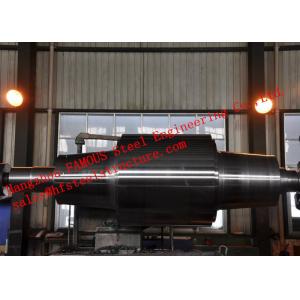Stainless Water Proof High Wear-resistance Forged Steel Rolls for Hot-rolling Mills
Blooming, slabbing and breakdown mills, as well as roughing stands of section and structural mills require that the rolls endure high temperatures and heavy dynamic loads.
Solid-forged rolls made of carbon tool steels are characterized by high hardness and wear-resistance. Depending on the service conditions, heat checking resistance is provided by complex alloying using either chromium, molybdenum, or vanadium.
Design features
Roll ends can be made in the form of tenons, flat (fork type), cylindrical (with splines or key grooves).
Guaranteed features of forged steel rolls for hot-rolling mills
High wear-resistance
Slight tendency towards heat checking
High resistance to surface spalling, especially under conditions of high and unevenly distributed pressure on the roll barrel surface.
Specification
| Item | MC3 forged work roller steel rolling mill |
| Handcrafte | furnace rolls are comprised of statically cast trunions (ends) welded to a centrifugally cast roll body with our unique locking mechanism. |
| Temperture | can perform in high temperture |
| Advantage | Our dry rolls are comprised of statically cast trunions (ends) welded to a centrifugally cast roll body used in a tunnel furnace |
| our dry rolls will provide abundant fuel savings through reduced heat loss in the furnace |
Rolling mill for hot rolled or cold rolling metal sheet or billets etc.
Different functions of rolls rollers for steel mills:
Work rolls
Backup rolls - are intended to provide rigid support required by the working rolls to prevent bending under the rolling load.
Rolling balance system - to ensure that the upper work and back up rolls are maintained in proper position relative to lower rolls.
Roll changing devices - use of an overhead crane and a unit designed to attach to the neck of the roll to be removed from or inserted into the mill.
Mill protection devices - to ensure that forces applied to the backup roll chocks are not of such a magnitude to fracture the roll necks or damage the mill housing
Roll cooling and lubrication systems.
Pinions - gears to divide power between the two spindles, rotating them at the same speed but in different directions.
Gearing - to establish desired rolling speed.
Drive motors - rolling narrow foil product to thousands of horsepower.
Electrical controls - constant and variable voltages applied to the motors.
Coilers and uncoilers - to unroll and roll up coils of metal.
Slabs are the feed material for hot strip mills or plate mills and blooms are rolled to billets in a billet mill or large sections in a structural mill. The output from a strip mill is coiled and, subsequently, used as the feed for a cold rolling mill or used directly by fabricators. Billets, for re-rolling, are subsequently rolled in either a merchant, bar or rod mill. Merchant or bar mills produce a variety of shaped products such as angles, channels, beams, rounds (long or coiled) and hexagons.
DESCIPTION of Work Rolls or Backup Roller:
1) Material: Alloy Steel, Alloy Iron, Ductile Iron namely 9Cr3Mo, 70NiMoV etc.
2) Standard: GB, AISI, SAE, ASTM/ASME, EU, AS/NZS etc
3) Size: According to clients' drawing or design needs
4) Hardness: based on design specification
5) Chemical Composition and mechanical property: as specified.
Design features:
The sleeve makes the working surface 2 or more times thicker
Roll spindle can be used more than once
Guaranteed features of built-up (sleeved) backup rolls
Required uniform hardness of the sleeve
Reliability of sleeve fit on the shaft
No tendency towards cracking or barrel spalling
No metallurgical or structural defects
Minimal level of residual stress
No design flaws impairing the roll performance
we can do various customized work rolls ranging in different sizes and processes. please feel free to make any enquiries accordingly.

